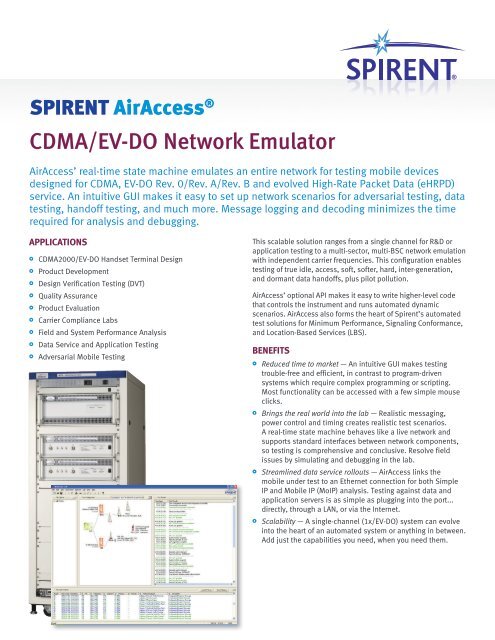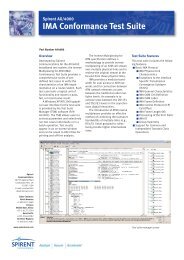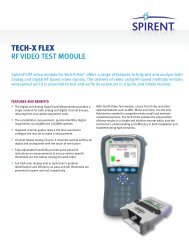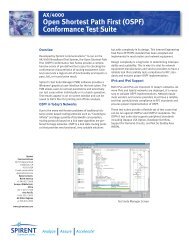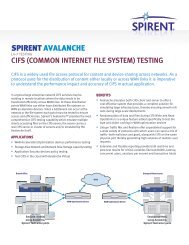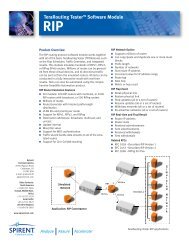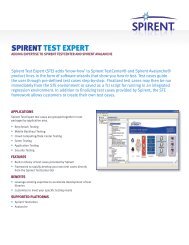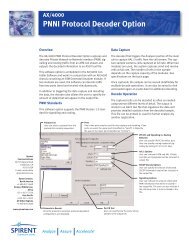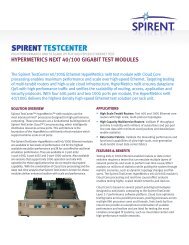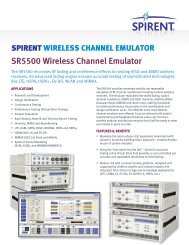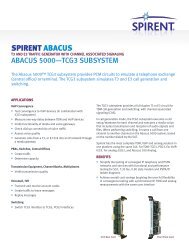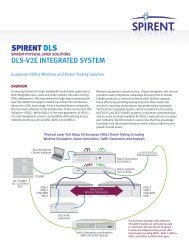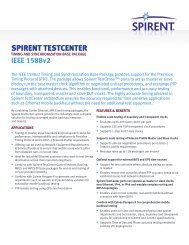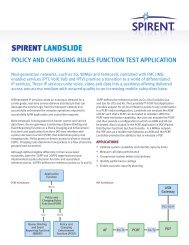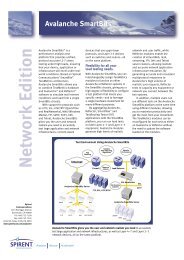CDMA/EV-DO Network Emulator - Spirent Communications
CDMA/EV-DO Network Emulator - Spirent Communications
CDMA/EV-DO Network Emulator - Spirent Communications
Create successful ePaper yourself
Turn your PDF publications into a flip-book with our unique Google optimized e-Paper software.
spirent AirAccess ®<br />
<strong>CDMA</strong>/<strong>EV</strong>-<strong>DO</strong> <strong>Network</strong> <strong>Emulator</strong><br />
AirAccess’ real-time state machine emulates an entire network for testing mobile devices<br />
designed for <strong>CDMA</strong>, <strong>EV</strong>-<strong>DO</strong> Rev. 0/Rev. A/Rev. B and evolved High-Rate Packet Data (eHRPD)<br />
service. An intuitive GUI makes it easy to set up network scenarios for adversarial testing, data<br />
testing, handoff testing, and much more. Message logging and decoding minimizes the time<br />
required for analysis and debugging.<br />
APPLICATIONS<br />
• <strong>CDMA</strong>2000/<strong>EV</strong>-<strong>DO</strong> Handset Terminal Design<br />
• Product Development<br />
• Design Verification Testing (DVT)<br />
• Quality Assurance<br />
• Product Evaluation<br />
• Carrier Compliance Labs<br />
• Field and System Performance Analysis<br />
• Data Service and Application Testing<br />
• Adversarial Mobile Testing<br />
This scalable solution ranges from a single channel for R&D or<br />
application testing to a multi-sector, multi-BSC network emulation<br />
with independent carrier frequencies. This configuration enables<br />
testing of true idle, access, soft, softer, hard, inter-generation,<br />
and dormant data handoffs, plus pilot pollution.<br />
AirAccess’ optional API makes it easy to write higher-level code<br />
that controls the instrument and runs automated dynamic<br />
scenarios. AirAccess also forms the heart of <strong>Spirent</strong>’s automated<br />
test solutions for Minimum Performance, Signaling Conformance,<br />
and Location-Based Services (LBS).<br />
Benefits<br />
• Reduced time to market — An intuitive GUI makes testing<br />
trouble-free and efficient, in contrast to program-driven<br />
systems which require complex programming or scripting.<br />
Most functionality can be accessed with a few simple mouse<br />
clicks.<br />
• Brings the real world into the lab — Realistic messaging,<br />
power control and timing creates realistic test scenarios.<br />
A real-time state machine behaves like a live network and<br />
supports standard interfaces between network components,<br />
so testing is comprehensive and conclusive. Resolve field<br />
issues by simulating and debugging in the lab.<br />
• Streamlined data service rollouts — AirAccess links the<br />
mobile under test to an Ethernet connection for both Simple<br />
IP and Mobile IP (MoIP) analysis. Testing against data and<br />
application servers is as simple as plugging into the port...<br />
directly, through a LAN, or via the Internet.<br />
• Scalability — A single-channel (1x/<strong>EV</strong>-<strong>DO</strong>) system can evolve<br />
into the heart of an automated system or anything in between.<br />
Add just the capabilities you need, when you need them.
SPIRENT AirAccess<br />
<strong>CDMA</strong>/<strong>EV</strong>-<strong>DO</strong> <strong>Network</strong> <strong>Emulator</strong><br />
FEATURES<br />
• 2G, 3G/<strong>EV</strong>-<strong>DO</strong> Rev. 0, Rev. A and Rev. B network emulation<br />
with inter-generational handoff<br />
• The only complete and realistic Evolved Packet Core (EPC)<br />
emulation.<br />
• Real-time state machine for realistic messaging and message<br />
timing<br />
• Powerful GUI for easy test scenario creation without script<br />
generation or software programming<br />
• Multi-sector, multi-BSC emulation and two independent<br />
carrier frequencies for true soft, softer and hard handoffs,<br />
dormant handoffs between <strong>CDMA</strong>2000 1X and 1x<strong>EV</strong>-<strong>DO</strong><br />
systems, plus pilot pollution testing<br />
INTUITIVE GUI FOR FAST, ERROR-FREE SETUP<br />
DVT, debugging and testing should not be bottlenecks in<br />
achieving your time-to-market goals.<br />
AirAccess’ graphical software lets you zoom in on low-level<br />
parameters without having to pore through manuals or<br />
specifications. Designed by engineers for engineers, the GUI’s<br />
clean interface makes it easy to “dive deep” and control the fine<br />
details of emulating a complete network.<br />
With AirAccess, details are coded into drop-down boxes and<br />
laid out so that the most complex network configuration can be<br />
set up in a few minutes, with just a few mouse clicks. Once a<br />
configuration has been set, it can be saved and stored for future<br />
use.<br />
• Instrument API for integration with automated Minimum<br />
Performance, Signaling Conformance, and Location-Based<br />
Services systems<br />
• In-depth Fast Forward Power Control (FFPC) testing<br />
• Real-time message and event analyzer displays and logs<br />
Layer 2 and Layer 3 messages<br />
• Other<br />
••<br />
<strong>EV</strong>-<strong>DO</strong> Rev. A QoS support<br />
••<br />
Overlay Services (SMS, OTA, data, E911)<br />
••<br />
Test Application Protocol (TAP), Enhanced TAP (ETAP) and<br />
Multi-Carrier TAP (MCTAP)<br />
••<br />
Embedded Mobile IP & DMU support<br />
••<br />
eHRPD<br />
Drop-down boxes and intuitive layout make<br />
configuration fast, clean, and efficient.
SPIRENT AirAccess<br />
<strong>CDMA</strong>/<strong>EV</strong>-<strong>DO</strong> <strong>Network</strong> <strong>Emulator</strong><br />
REAL-TIME STATE MACHINE<br />
AirAccess uses a real-time state machine rather than a scriptdriven<br />
simulation. All overhead, Layer 2 and Layer 3 messages<br />
are delivered with the same timing and with the same real-life<br />
responses as a live network.<br />
Never again miss a timing bug because a script-driven state<br />
machine wasn’t capable of catching it. Never miss a protocol bug<br />
because a “call box” or “one-box radio test set” in the lab did not<br />
fully implement real-world network/packet core responses.<br />
OPTIONAL API FOR CUSTOM AUTOMATION<br />
The available AirAccess Instrument Applications Programming<br />
Interface (I-API) is the same powerful API used to integrate<br />
AirAccess C2K into the industry’s most trusted automated test<br />
systems. The AirAccess I-API is accessed as a COM object,<br />
affording very efficient code development. Drop-down boxes and<br />
sample code make software control of the AirAccess nearly as<br />
straightforward as using the GUI. In fact, the AirAccess I-API offers<br />
code control of all the same functionality found in the AirAccess<br />
C2K GUI.<br />
Real-time network emulation using a dynamic state machine.<br />
MESSAGE AND <strong>EV</strong>ENT ANALYSIS<br />
As you work with AirAccess, the software continually parses and<br />
logs the Layer 2 and Layer 3 messaging required in the interface<br />
between a mobile and a network. Unlike script-based protocol<br />
testers, AirAccess’ full-featured protocol engine constantly verifies<br />
message contents, just as a live network will.<br />
Double-clicking a message in the Message Analyzer window<br />
displays a fully parsed and decoded message for “deep-dive”<br />
analysis of message fields. Bugs that might otherwise take hours<br />
to find (or never be caught) are brought to the forefront in a<br />
matter of seconds.<br />
Many AirAccess customers claim that this feature alone has saved<br />
them from weeks of lost time, and in some cases from deploying<br />
a buggy product.<br />
AirAccess captures and decodes messaging so it’s easy to isolate DUT<br />
issues.
SPIRENT AirAccess<br />
<strong>CDMA</strong>/<strong>EV</strong>-<strong>DO</strong> <strong>Network</strong> <strong>Emulator</strong><br />
TECHNICAL SPECIFICATIONS<br />
The following specifications describe warranted performance over the temperature range 0-40 degrees C and include a 30 minute<br />
warm-up time from ambient conditions. All specifications are measured at 892.7 MHz and 1962.5 MHz unless stated otherwise.<br />
Supplemental characteristics are in italics and provide useful information by giving non-warranted performance parameters.<br />
RF GENERATOR<br />
Pilot Relative Level<br />
-63.0 to -0.1 dB (0.1 dB res)<br />
Sync Relative Level<br />
-63.0 to -0.1 dB (0.1 dB res)<br />
Paging Relative Level<br />
-63.0 to -0.1 dB (0.1 dB res)<br />
QPCH Relative Level<br />
-63.0 to -0.1 dB (0.1 dB res)<br />
FCH Relative Level<br />
-63.0 to -0.1 dB (0.1 dB res)<br />
SCH Relative Level<br />
-63.0 to -0.1 dB (0.1 dB res)<br />
OCNS Walsh Code Length Fixed to 64<br />
OCNS Relative Level Range<br />
Calculated automatically from the relative levels of the other code channels to provide a<br />
composite power level that is equal to the programmed sector power<br />
<strong>CDMA</strong> Modulation<br />
Modulation Type:<br />
1X: Parallel BPSK for Pilot, Sync and Paging channels;<br />
Complex QPSK for FHS and SCH channels<br />
1x<strong>EV</strong>-<strong>DO</strong>:<br />
BPSK, QPSK, 8-PSK, 16-QAM<br />
Independent RF Carriers<br />
1 RF output per SR3452 V2<br />
Frequency Frequency Range: Band Class 0 (869 MHz to 894 MHz)<br />
Band Class 1 (1930 MHz to 1990 MHz)<br />
Band Class 3 (832 MHz to 869 MHz)<br />
Band Class 4 (1840 MHz to 1870 MHz)<br />
Band Class 5 (421 MHz to 494 MHz)<br />
Band Class 6 (2110 MHz to 2170 MHz)<br />
Band Class 14 (1930 MHz to 1995 MHz)<br />
Class 15 (2110 MHz to 2155 MHz)<br />
Frequency Resolution:<br />
500 Hz<br />
Frequency Setting:<br />
By channel number<br />
Amplitude RF Output Level Range: -100 dBm/1.23 MHz to -38 dBm/1.23 MHz<br />
RF Output Level Resolution: 0.1 dB<br />
Absolute Output Level Accuracy: ±1 dB<br />
<strong>CDMA</strong> Modulation Quality Residual Rho > 0.99<br />
RF RECEIVER<br />
Independent RF Carriers<br />
1 RF output per SR3452 V2<br />
Frequency Frequency Range: Band Class 0 (824 MHz to 849 MHz)<br />
Band Class 1 (1850 MHz to 1910 MHz)<br />
Band Class 3 (887 MHz to 925 MHz)<br />
Band Class 4 (1750 MHz to 1780 MHz)<br />
Band Class 5 (411 MHz to 484 MHz)<br />
Band Class 6 (1920 MHz to 1980 MHz)<br />
Band Class 14 (1850 MHz to 1915 MHz)<br />
Band Class 15 (1710 MHz to 1755 MHz)<br />
Frequency Resolution:<br />
500 Hz<br />
Input Level Range<br />
-50 dBm/1.23 MHz to 25 dBm/1.23 MHz
SPIRENT AirAccess<br />
<strong>CDMA</strong>/<strong>EV</strong>-<strong>DO</strong> <strong>Network</strong> <strong>Emulator</strong><br />
TECHNICAL SPECIFICATIONS (CONT’D)<br />
TIMEBASE SPECIFICATIONS<br />
Internal System Reference<br />
Frequency<br />
10 MHz<br />
Accuracy<br />
± 0.05 ppm<br />
Stability Temperature ± 0.015 ppm<br />
Aging<br />
± 0.001 ppm/day<br />
Phase Noise @ 1 kHz offset<br />
-165 dBc/Hz<br />
Output Connector BNC-type, female<br />
Impedance/Coupling<br />
50 W/AC<br />
Level<br />
1 VPP<br />
Impedance/Coupling<br />
Level<br />
TRIGGER/CLOCK/SYNC INTERFACES<br />
<strong>CDMA</strong> Trigger Output (1X) Connector DB-25, female<br />
Signals<br />
Frame boundaries (1.25, 20, 26.67 and 80 ms)<br />
PPS2 (even-second pulse)<br />
PN-1 and PN-Q (I and Q channel pseudorandom Noise)<br />
1x (1 times chip rate) clock – 1.2288 MHz<br />
2x (2 times chip rate) clock<br />
(frame boundaries and PPS2 are active-high,<br />
50ns Wide pulse)<br />
Band Class 15 (1710 MHz to 1755 MHz)<br />
Level<br />
LVTTL<br />
Clocks (1X) Connector BNC, female<br />
Signals<br />
CHIPx16 Out (16 times chip rate output)<br />
CHIPx16 in (16 times chip rate input)<br />
Level<br />
LVTTL<br />
Sync Connector BNC, female<br />
Signals<br />
PP2S Out (even second pulse output) active high,<br />
100ns wide pulse<br />
Level<br />
LVTTL
SPIRENT AirAccess<br />
<strong>CDMA</strong>/<strong>EV</strong>-<strong>DO</strong> <strong>Network</strong> <strong>Emulator</strong><br />
ADVANCED OVERLAY SERVICES<br />
AirAccess uses built-in application-specific routines to simplify<br />
testing of advanced services overlaid on the <strong>CDMA</strong> air interface<br />
protocol. An intuitive graphical user interface aids in verifying<br />
Authentication, Encryption, Voice Privacy, OTASP/OTAPA, and<br />
Two-way SMS (including broadcast SMS).<br />
DATA PERFORMANCE ANALYSIS<br />
AirAccess was the first network emulation solution with a fullbandwidth<br />
IP connection between the emulated network and<br />
networked equipment. A simple Ethernet cable is all that’s<br />
required to connect a mobile under test to data servers, file<br />
servers, and even Internet-hosted web sites and servers.<br />
This industry-leading focus on data testing means that AirAccess<br />
provides much more than just a “pipe” to data servers. AirAccess<br />
also includes the network entities (IWF, PCF, PDSN, IWF, SMS<br />
Server and OTA Server) required to provide overlay services<br />
and high-speed packet data services for complete mobile<br />
performance testing.<br />
SINGLE-CHANNEL OPTION<br />
The single-channel version of the AirAccess <strong>CDMA</strong>/<strong>EV</strong>-<strong>DO</strong> <strong>Network</strong><br />
<strong>Emulator</strong> is a single-carrier bench-top network emulator. This<br />
scalable solution is just right for mobile device R&D, testing data<br />
application performance or protocol implementations.<br />
The single-channel AirAccess is also the smart choice when<br />
you need professional emulation now and have plans that may<br />
grow your needs in the future. As requirements and business<br />
opportunities evolve, this bench-top solution can develop into a<br />
multi-carrier emulator or even to a large-scale automated device<br />
test system.<br />
This configuration can be used as either a <strong>CDMA</strong>, <strong>EV</strong>-<strong>DO</strong> Rev. 0,<br />
or <strong>EV</strong>-<strong>DO</strong> Rev. A network emulator. It includes integrated PDSN<br />
emulation, so data application testing can begin as soon as you<br />
add the application server.<br />
AirAccess’ data-testing capabilities include:<br />
• <strong>EV</strong>-<strong>DO</strong> packet data using the Default Packet Application and<br />
Multi-Flow Packet Application<br />
• RLP1, RLP2 and RLP3<br />
• Asynchronous data and facsimile transmission<br />
• RLP, PPP and TCP/UDP monitoring points<br />
• Functional testing via popular software applications<br />
• Ethernet data port for connection to external servers or test<br />
equipment<br />
Intuitive GUI allows easy testing of<br />
advanced services.
SPIRENT AirAccess<br />
<strong>CDMA</strong>/<strong>EV</strong>-<strong>DO</strong> <strong>Network</strong> <strong>Emulator</strong><br />
eHRPD OPTION<br />
AirAccess’ new Evolved High-Rate Packet Data (eHRPD) option<br />
helps <strong>CDMA</strong>/<strong>EV</strong>-<strong>DO</strong> wireless network operators and device<br />
makers prepare for the transition towards the 3GPP’s Long-Term<br />
Evolution (LTE) technology.<br />
eHRPD will enable seamless mobility between the existing 3G<br />
network and LTE services which are currently being launched.<br />
The resulting overlay network has to offer nation-wide <strong>EV</strong>-<strong>DO</strong><br />
service, pockets of LTE service and a transparent linkage between<br />
the two. This all introduces a new level of complexity in software<br />
and signaling protocols, and that means there is a new level of<br />
complexity in DVT and testing.<br />
Since the long-term success of this complex transition will<br />
depend largely on the subscriber’s first experience, the industry<br />
needs mobile devices that work right the first time. Proper mobile<br />
device testing requires a network emulator that accurately<br />
emulates new functional elements as well as legacy elements,<br />
and can deliver their outputs to the DUT in real time<br />
AirAccess’ excellent interactive bench-top capabilities are<br />
especially beneficial when you are developing new technology.<br />
The intuitive easy-to-use GUI alone shaves weeks off of time-tomarket<br />
schedules.<br />
Message and Event Analysis<br />
Any new protocol such as eHRPD introduces new places for bugs<br />
to hide. AirAccess’ renowned event analysis, real-time message<br />
decoding and logging help you uncover bugs quickly and<br />
painlessly. With AirAccess’ real-time state machine, you won’t<br />
miss bugs related to timing or unimplemented/reserved message<br />
fields. AirAccess is indispensable for the DVT and debugging<br />
cycles of eHRPD device development.<br />
Rich Protocol Implementation Aligned With carrier Requirements<br />
AirAccess roadmap is designed per information from cutting-edge<br />
network operators. Development is ongoing so you’ll always have<br />
the protocol and signaling functionality you need to meet carrier<br />
requirements for the foreseeable future:<br />
• Improved Extensible Authentication Protocol Method for 3rd<br />
Generation Authentication and Key Agreement (EAP-AKA')<br />
• Vendor-Specific <strong>Network</strong> Protocol (VSNP) and the associated<br />
Vendor-Specific <strong>Network</strong> Control Protocol (VSNCP)<br />
• PDN Connection Control Messages (PCCM) for PDN to assign<br />
IPv4 (for legacy applications) or IPv6 IP addresses to the<br />
mobile.<br />
• “Always-on” IPv6 as well as IPv4 on demand<br />
• Proxy Mobile IP (PMIP) – network-based mobility management<br />
performed network based<br />
• Enhanced Multiflow Packet Application (EMFPA), including<br />
Radio Link Protocol (RLP), Location Update Protocol (LUP),<br />
Flow Control Protocol (FCP)<br />
••<br />
Negotiation of EMFPA attributes and logging/decoding of<br />
EMFPA over-the air signaling messages.<br />
Adversarial Testing<br />
The eHRPD option adds new scenarios to AirAccess’ existing<br />
adversarial testing capabilities. Easily and intuitively emulate<br />
these network conditions:<br />
• PDSN/FA error scenarios (<strong>EV</strong>-<strong>DO</strong>)<br />
• PDSN does not send IPCP Configuration Request (<strong>EV</strong>-<strong>DO</strong>)<br />
• PDSN does not respond to IPCP message from UE (<strong>EV</strong>-<strong>DO</strong>)<br />
• PDSN/FA does not send Agent Advertisement when mobile<br />
sends Agent Solicitation (<strong>EV</strong>-<strong>DO</strong>)<br />
• HSGW unavailable (two modes)<br />
• IP address pool depletion<br />
• PPP-VSNCP Configuration Reject from HSGW to UE<br />
• No response to VSNCP Configure Request<br />
• HSGW doesn't send Advertisement for IPv6 prefix allocation<br />
• PPP-LCP Protocol Reject from HSGW to UE<br />
• PPP-VSNCP Terminate Request from HSGW to UE<br />
• EAP Failure Packets (AKA-Client-Error, AKA-Authentication-<br />
Reject, AKA-Synchronization-Failure)<br />
eHRPD parameter control is built into the AirAccess Instrument<br />
Application Programming Interface (I-API) to facilitate custom<br />
automation. Exhaustive customized testing can be created and<br />
run with complete consistency.<br />
<strong>EV</strong>-<strong>DO</strong> R<strong>EV</strong>. B OPTION<br />
AirAccess offers multi-carrier <strong>EV</strong>-<strong>DO</strong> Rev B emulation to align with<br />
carriers’ current large-scale Rev. B rollouts. You can even emulate<br />
a 1X or Rev. A signal simultaneously with your multiple-carrier Rev<br />
B signal. Advanced features include:<br />
• Multi-carrier Test Application Protocol (MCTAP)<br />
• Bi-directional data throughput at maximum rates (critical for<br />
data testing)<br />
• Dynamic adding or dropping of carriers
SPIRENT AirAccess<br />
<strong>CDMA</strong>/<strong>EV</strong>-<strong>DO</strong> <strong>Network</strong> <strong>Emulator</strong><br />
ORDERING INFORMATION<br />
HARDWARE PART NUMBERS<br />
AA3452RF-BX-R01 AirAccess C2K Single Channel RF <strong>Network</strong> Emulation:<br />
– <strong>CDMA</strong> <strong>Network</strong> <strong>Emulator</strong><br />
– Packet Core <strong>Network</strong> <strong>Emulator</strong> with real-time emulation of multiple PDSN nodes, Mobile IP and Simple IP simulation,<br />
Inter-PDSN handoffs<br />
– Main Application Software<br />
– Custom-configured computer with pre-installed software<br />
– AAC2K-HSPD, AAC2K-OSVC, AAC2K-APIRUN Software Modules<br />
AA3452RF-CX-R01 AirAccess C2K Dual Channel RF <strong>Network</strong> Emulation:<br />
– Equivalent to AA3452RF-BX-R01 with two RF channels<br />
AAC2K-TOTAL-HX AirAccess C2K Dual Channel RF <strong>Network</strong> Emulation:<br />
– Equivalent to AA3452RF-CX-R01 plus software modules AAC2K-MIP, AAC2K-95B, AAC2K-DMU<br />
AA-1XPLUS-EX AirAccess 1xPLUS <strong>Network</strong> Emulation<br />
– Equivalent to AA3452RF-CX-R01 plus SR3462 <strong>EV</strong>-<strong>DO</strong> Rev. 0 and <strong>EV</strong>-<strong>DO</strong> Rev. A <strong>Emulator</strong><br />
– AAC2K-95B, AAC2K-MIP software modules<br />
AA-CFG3-SYS-01 AirAccess Single Channel RF <strong>Network</strong> Emulation:<br />
– SR3452 <strong>CDMA</strong> <strong>Network</strong> <strong>Emulator</strong><br />
– SR3462 <strong>EV</strong>-<strong>DO</strong> . 0/Rev. A <strong>Network</strong> <strong>Emulator</strong> with internal Core <strong>Network</strong> <strong>Emulator</strong> and Switch<br />
– Main Application Software<br />
– Custom configured computer with pre-installed software<br />
– AAC2K-APIRUN Software module<br />
Note: This one-channel configuration provides either <strong>CDMA</strong> or <strong>EV</strong>-<strong>DO</strong> RF simulation but not both simultaneously.<br />
AirAccess OPTIONS<br />
AAC2K-HSPD High-Speed Packet Data Software Module (option)<br />
– Emulates RLP, PCF and PDSN for high-speed packet data testing<br />
AAC2K-OSVC Overlay Services Software Module (option)<br />
– Emulates SMS server and OTA server for two-way SMS, OTASP and OTAPA testing<br />
AAC2K-95B<br />
IS-95-B Software Module<br />
– Air interface support for the IS-95-B specification<br />
AAC2K-MIP<br />
Mobile IP Software Module<br />
– Emulates Home Agent (HA) and Foreign Agent (FA) for Mobile IP testing<br />
AAC2K-DMU<br />
Dynamic Mobile IP Key Update Software Module (option)<br />
– Emulates DMU functionality for over-the-air Mobile IP key exchange testing<br />
AAC2K-SMSC-CLNT SMSC Client Software Module<br />
– SMSC Client interfaces with third-party MMS server for MMS testing.<br />
AAC2K-QOS<br />
<strong>EV</strong>-<strong>DO</strong> Rev. A QoS Software Module<br />
– GUI-based control of QoS profiles and mapping profiles<br />
AAC2K-APISDK Instrument API Software Development Kit (option)<br />
– Documentation - Instrument API function library<br />
– Example scripts written in Visual Basic<br />
– Instrument API runtime license<br />
– First year of Instrument API SDK Annual Support Agreement<br />
– AAC2K-APIRUN Instrument API Runtime License (option, required top execute I-API scripts)<br />
AAC2K-EHRPD – eHRPD option for AirAccess<br />
AAC2K-<strong>DO</strong>RB – <strong>EV</strong>-<strong>DO</strong> Rev B option for AirAccess<br />
<strong>Spirent</strong> GLOBAL services<br />
<strong>Spirent</strong> Global Services provides a variety of professional services, support services and education services — all focused on helping<br />
customers meet their complex testing and service assurance requirements. For more information, visit the Global Services’ website at<br />
www.spirent.com/gs or contact your <strong>Spirent</strong> sales representative.<br />
Americas 1-800-SPIRENT • +1-818-676-2683 • sales@spirent.com<br />
Europe and the Middle East +44 (0) 1293 767979 • emeainfo@spirent.com<br />
Asia and the Pacific +86-10-8518-2539 • salesasia@spirent.com<br />
© 2010 <strong>Spirent</strong> <strong>Communications</strong>, Inc. All of the company names and/or brand names and/or product names referred to in this document,<br />
in particular the name “<strong>Spirent</strong>” and its logo device, are either registered trademarks or trademarks pending registration in accordance with<br />
relevant national laws. All rights reserved. Specifications subject to change without notice. Rev. C 04/10


